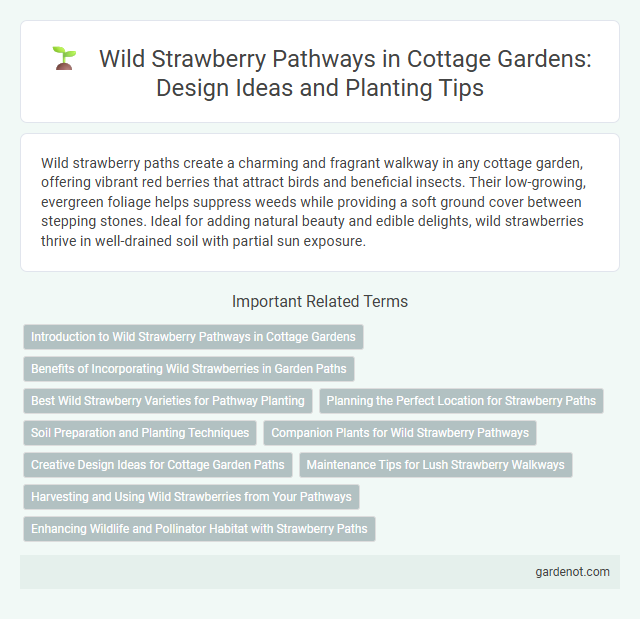Wild strawberry paths create a charming and fragrant walkway in any cottage garden, offering vibrant red berries that attract birds and beneficial insects. Their low-growing, evergreen foliage helps suppress weeds while providing a soft ground cover between stepping stones. Ideal for adding natural beauty and edible delights, wild strawberries thrive in well-drained soil with partial sun exposure.
Introduction to Wild Strawberry Pathways in Cottage Gardens
Wild Strawberry Pathways are a charming feature in cottage gardens, combining natural beauty with practical use. These pathways utilize the low-growing, fragrant wild strawberry plants (Fragaria vesca) to create green, edible walkways that enhance garden aesthetics and provide seasonal fruit. Their resilience and ability to thrive in partial shade make them ideal for adding texture and scent while supporting biodiversity in traditional cottage garden settings.
Benefits of Incorporating Wild Strawberries in Garden Paths
Incorporating wild strawberries in garden paths enhances soil health by providing natural ground cover that reduces erosion and retains moisture. Their low-growing habit suppresses weeds, minimizing maintenance while creating a lush, green carpet dotted with edible red berries. This integration not only attracts pollinators but also adds aesthetic and functional value to cottage garden landscapes.
Best Wild Strawberry Varieties for Pathway Planting
Choosing the best wild strawberry varieties for pathway planting enhances both aesthetics and functionality in a cottage garden. Varieties like Fragaria vesca 'Mignonette' and 'Alexandria' offer vigorous growth, fragrant flowers, and edible fruit, making them ideal for ground cover along garden paths. Their low-growing habit and tolerance to foot traffic create a lush, fragrant, and practical pathway that complements traditional cottage garden designs.
Planning the Perfect Location for Strawberry Paths
Select a well-drained spot with full sun exposure to maximize wild strawberry growth and fruit production. Incorporate pathways that allow easy access for harvesting while preventing soil compaction around the plants. Ensure the soil is rich in organic matter and slightly acidic, with a pH between 5.5 and 6.5, to create ideal conditions for strawberry roots.
Soil Preparation and Planting Techniques
Effective soil preparation for a wild strawberry path involves enriching well-drained soil with organic matter such as compost or aged manure to enhance fertility and moisture retention. Planting techniques prioritize spacing runners 12 to 18 inches apart to allow adequate air circulation and prevent fungal diseases while planting crowns just below the soil surface to encourage healthy root development. Consistent moisture and mulching with straw or pine needles help suppress weeds, retain soil moisture, and protect delicate roots.
Companion Plants for Wild Strawberry Pathways
Companion plants for wild strawberry pathways include herbs like thyme and chamomile, which enhance soil health while deterring pests. Ground covers such as creeping phlox and sweet alyssum increase visual appeal and reduce weed growth. These companion plants promote a thriving ecosystem, improving the overall vitality and fragrance of the cottage garden.
Creative Design Ideas for Cottage Garden Paths
Wild strawberry paths in cottage gardens create charming, fragrant walkways that combine aesthetics with edible landscaping. Incorporating low-growing wild strawberries as ground cover along garden paths enhances both texture and color, while their sweet fruit offers seasonal rewards. Use natural stone edging or reclaimed wood borders to define the path, blending rustic elements with lush greenery for a truly whimsical, inviting cottage garden experience.
Maintenance Tips for Lush Strawberry Walkways
Regular weeding is essential to prevent wild strawberries from being overtaken by invasive plants, ensuring healthy growth and vibrant fruit production. Mulching with organic materials like straw or wood chips conserves moisture and suppresses weeds, promoting a lush strawberry walkway. Consistent watering, especially during dry spells, keeps the soil moist and supports the plant's extensive root system for a thriving cottage garden path.
Harvesting and Using Wild Strawberries from Your Pathways
Harvest wild strawberries from your garden pathways when they turn a bright red for the sweetest flavor and highest nutritional value. These small, aromatic berries can be used fresh in salads, desserts, or homemade jams to enhance your cottage garden produce. Regular harvesting encourages continuous fruiting and prevents overripe berries from attracting pests.
Enhancing Wildlife and Pollinator Habitat with Strawberry Paths
Wild strawberry paths provide a natural ground cover that attracts a variety of pollinators such as bees and butterflies, enhancing biodiversity within cottage gardens. These low-growing plants produce edible fruits that support birds and small mammals while creating a seamless habitat corridor for wildlife. Integrating wild strawberry paths increases ecological resilience by offering food resources and shelter throughout the growing season.
Wild strawberry path Infographic

 gardenot.com
gardenot.com